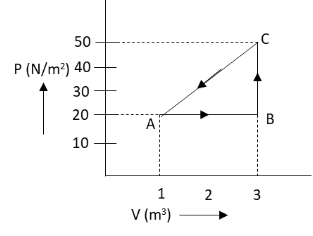
In the diagram, the graph between volume and pressure for a thermodynamic process in shown, if

A.
B.
C.
D.

Answer
474.3k+ views
Hint:Use the formula for pressure volume work done by the gas. This formula gives the relation between the pressure of the gas and change in volume of the gas. From this formula equation, determine the work done by the gas from point B to C. Use the formula for heat exchanged by the gas with the surrounding in terms of change in internal energy of the gas. Hence, calculate the internal energy of the gas at stage C.
Formulae used:
The pressure volume work
Here,
The heat exchanged
Here,
Complete step by step answer:
We have given the graph between the volume and pressure of a gas for a thermodynamic process. The internal energy of the gas at point A and B is
The energy given to the gas from point B to C is
We have asked to determine the internal energy of the system at stage C. In the given pressure volume graph, we can see that the volume of the gas from point B to C is constant. Hence, the change in volume of the gas from point B to C is zero. Hence, according to equation (1), the pressure volume work done by the gas from point B to C Is zero.
The change in internal energy of the gas from point B to C is given by
Let now calculate the internal energy of the gas at point C using equation (2).
Substitute
Rearrange the above equation for
Substitute
Therefore, the internal energy of the gas at stage C is
Hence, the correct option is A.
Note:The students should not get confused between the difference values of the energy given in the question. The energy is given to the system of gas from point B to C. This energy is the energy provided by the surrounding to the system of gas in the thermodynamic process and not the work done by the gas from point B to C or any other energy.
Formulae used:
The pressure volume work
Here,
The heat exchanged
Here,
Complete step by step answer:
We have given the graph between the volume and pressure of a gas for a thermodynamic process. The internal energy of the gas at point A and B is
The energy given to the gas from point B to C is
We have asked to determine the internal energy of the system at stage C. In the given pressure volume graph, we can see that the volume of the gas from point B to C is constant. Hence, the change in volume of the gas from point B to C is zero. Hence, according to equation (1), the pressure volume work done by the gas from point B to C Is zero.
The change in internal energy of the gas from point B to C is given by
Let now calculate the internal energy of the gas at point C using equation (2).
Substitute
Rearrange the above equation for
Substitute
Therefore, the internal energy of the gas at stage C is
Hence, the correct option is A.
Note:The students should not get confused between the difference values of the energy given in the question. The energy is given to the system of gas from point B to C. This energy is the energy provided by the surrounding to the system of gas in the thermodynamic process and not the work done by the gas from point B to C or any other energy.
Recently Updated Pages
Express the following as a fraction and simplify a class 7 maths CBSE

The length and width of a rectangle are in ratio of class 7 maths CBSE

The ratio of the income to the expenditure of a family class 7 maths CBSE

How do you write 025 million in scientific notatio class 7 maths CBSE

How do you convert 295 meters per second to kilometers class 7 maths CBSE

Write the following in Roman numerals 25819 class 7 maths CBSE

Trending doubts
State and prove Bernoullis theorem class 11 physics CBSE

What are Quantum numbers Explain the quantum number class 11 chemistry CBSE

Write the differences between monocot plants and dicot class 11 biology CBSE

Who built the Grand Trunk Road AChandragupta Maurya class 11 social science CBSE

1 ton equals to A 100 kg B 1000 kg C 10 kg D 10000 class 11 physics CBSE

State the laws of reflection of light




